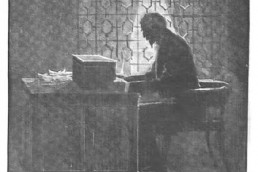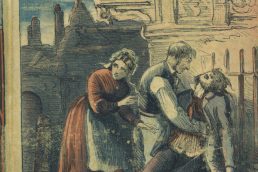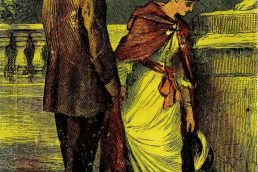Serialised fiction in the Bolton Weekly Journal – The Lasses of Leverhouse (1878-79) by Jessie Fothergill


Jessie Fothergill’s novel, The Lasses of Leverhouse (1888), was first serialised in the Bolton Weekly Journal in weekly instalments between November 1878 to March 1879 (Troy J. Bassett, 2020).
Fothergill was born in Cheetham Hill, Manchester in 1851, and “came from a long and respectable line of yeoman Quakers” (Jane Crisp, 2021). In an 1890 interview with Helen Black, Fothergill “describes how she rejected the young lady role, finding happiness in reading omnivorously, in rambling about the Tadmorden Valley, in studying ‘the routine of the great cotton and flannel mills, the odd habits, the queer sayings and doings of workpeople’, and in writing stories in an attic.” The Lasses of Leverhouse, “with its novelstruck adolescent narrator and her impoverished but boisterous family clearly draws on this period of its author’s own life” (qtd in Crisp, 2021).
William Sharp wrote of the novel in The Academy that “the author of those charming novels, The First Violin and Probation, could hardly do otherwise than write well and pleasantly; but The Lasses of Leverhouse is — well, the author should have been content with it’s serial appearance in the Bolton Journal.” His reasoning is that the story is not an “unworthy one; the objection is that it is simply much below the literary level of the books Miss Fothergill has made her deservedly high reputation” (1888, p.428). He comments that the Howarth’s [the protagonist’s family] are a “pleasant family; and it is something to be thankful for to have associated for an hour or two with real people, even though the narrative of their sins, follies, and virtues be as uneventful and unexciting as a day’s roach fishing in a midland stream” (1888, p.428).
An anonymous writer for The Athenaeum alternatively wrote that The Lasses of Leverhouse is “a “story revived” having made its first appearance in the Bolton Journal.” They comment that the novel is done “in something is a Broughtonesque vein, but with less smartness and flippancy in the dialogue, and an undercurrent of stronger feeling. There are pretty touches of humour and pathos in the picture of child life, and there is some character as well; but the general effect is not of strength nor certainty, and the blindness inflicted upon one of the “lasses” is both unnecessary and unkind” (1888, p.694).
James S. Cotton, editor of The Academy offered the kindest review of her novel, though, commenting that “There is a youthful freshness and heartiness in the authors way of telling her story which makes the book particularly enjoyable” – Scotsman advertisement (1888, p.845).
Fothergill’s The Lasses of Leverhouse opens with a description of Victorian Bolton:
“Four miles from the town of Bolton, in Lancashire, lay, amongst the roughest moors, and separated from all other places as if it had been a little world in itself, the village of Hamerton. […] Hamerton itself – “the village,” as we always called it, from habit and association – was not really much of a village. It had been a real village once, until that great monarch, King Cotton, came to reign there, and brought in with him his court and train of attendants, in the shape of factories, long chimneys, much thick smoke, and crowds of busy factory-hands, whose clogged feet clattered periodically along the street, whose grey woollen shawls in winter were associated in my mind with my very earliest memories, as were also the roar of looms and the rush of spindles, the distant cloud of smoke which we could see from our front windows, and which, when a child, I used to think was an actual cloud, but which, my sister Alizon one day told me, was Bolton. For a long time I always thought of Bolton as a city somehow built in the air, and with a murky cloud floating round it, until hard reality showed it me as a very dirty town, into which we could penetrate either on foot or by means of trains or carriages.
I think I must have been about six years old when I was thus disillusioned, and I remember it still – the feeling of wonder and disappointment.
We were advancing in Hamerton. There were co-operative stores and a co-operative factory there, the latter known generally as “th’ co-op.” (Fothergill, 1888, pp.1-3)
Fothergill’s work was most well remembered for her evocative descriptions of place. Linda Gardiner wrote a critical assessment of Jessie Fothergill for the Novel Review the year after Fothergill’s death. Summarising Gardiner’s position, Jane Crisp notes Gardiner’s appreciation for “the enduring significance of any writer who captures a particular region and its people at a specific stage in its evolution”, and quotes Gardiner’s summation that Fothergill “writes with intelligent perception of the social revolutions or the intellectual storm and stress of the age in which he lives” (cited in Crisp, 2021).
Gardiner commented, however, that The Lasses of Leverhouse lacks the “forcefulness of vitality” (1892, p.155) of her other novels. She reflects that of all the novels she has critiqued for the Review, “the leading figure is [presented as] a strong nature at war with its surroundings, and partaking of the strength and the ruggedness, and what may be called the harshness, which are apparent in the style of the narrative” (p.155-6). Comparatively it is noted that her women are not portrayed in the usual style of the Victorian era. Gardiner suggests that they are “never of the drawing room order of heroine, conspicuous for a pretty face and girlish waywardness”. (p.156). She offers high praise in general for Miss Fothergill noting that her novels “have not been misspent or given in vain, and secure for her an honourable place among the novelists of the Victorian era” (p.160).
Bibliography
Anon. (1888) Novels of The Week. The Athenaeum [Online] June 1888 (3162). p. 693-694. Available at: <https://search-proquest-com.ezproxy.bolton.ac.uk/britishperiodicals/docview/8998537/D83B2540B1AE4BD7PQ/3?accountid=9653&imgSeq=2> [Accessed on 22 April 2021].
Bassett, T. (2020) At the Circulating Library Title Information: The Lasses of Leverhouse. [Online] Victorianresearch.org. Available at: <https://www.victorianresearch.org/atcl/show_title.php?tid=7611&aid=456> [Accessed 22 April 2021].
Black, Helen C. (1893) Notable Women Authors of the Day: Biographical Sketches. Glasgow: David Bryce and Son.
Brookes, Warwick. (n.d.) Jessie Fothergill. [19th Century] [Signed Photograph] [Online Photograph]. Available at: <https://en.wikipedia.org/wiki/Jessie_Fothergill#/media/File:Jessie_Fothergill.jpg> [Accessed 23 April 2021].
Cotton, J.S. (ed.) (1888) Advertisement. The Academy. [Online] July 1888 (845), p.3. Available at: <https://victorianfictionresearchguides.org/jessie-fothergill/> [Accessed 22 April 2021]
Co-operative Society (1900?). [Online Photograph] Available at: <https://www.boltonlams.co.uk/boltonlams/homepage/20/details?entry_id=14373> [Accessed 6 May 2021].
Crisp, J. (2021) Victorian Fiction Research Guides: Jessie Fothergill. [Online] Available at: <https://victorianfictionresearchguides.org/jessie-fothergill/> [Accessed 22 April 2021].
Fothergill, J. (1888) The Lasses of Leverhouse: A Story. London: Hurst and Blackett. [Online] Available at: <http://access.bl.uk/item/viewer/ark:/81055/vdc_000000048E94#?c=0&m=0&s=0&cv=8&xywh=-858%2C-144%2C4296%2C2238>[Accessed 6 May 2021].
Gardiner, L. (1892) Novel Review: Jessie Fothergill’s Novels. [Online] May 1892, 1(2), pp.153-160. London. Available at: <https://search-proquest-com.ezproxy.bolton.ac.uk/britishperiodicals/docview/6204329/D83B2540B1AE4BD7PQ/1?accountid=9653&imgSeq=1> [Accessed 22 April 2021].
Sharp, W. (1888) New Novels. The Academy: New Novels. [Online] June 1888 (842), pp.427-428. London. Available at: <https://search-proquest-com.ezproxy.bolton.ac.uk/britishperiodicals/docview/8183040/D83B2540B1AE4BD7PQ/2?accountid=9653&imgSeq=1> [Accessed on 22 April 2021].
View of Tannery from St Georges road. (n.d.) [Online photograph] Available at: <https://www.boltonlams.co.uk/boltonlams/homepage/20/details?entry_id=13084> [Accessed 6 May 2021].












